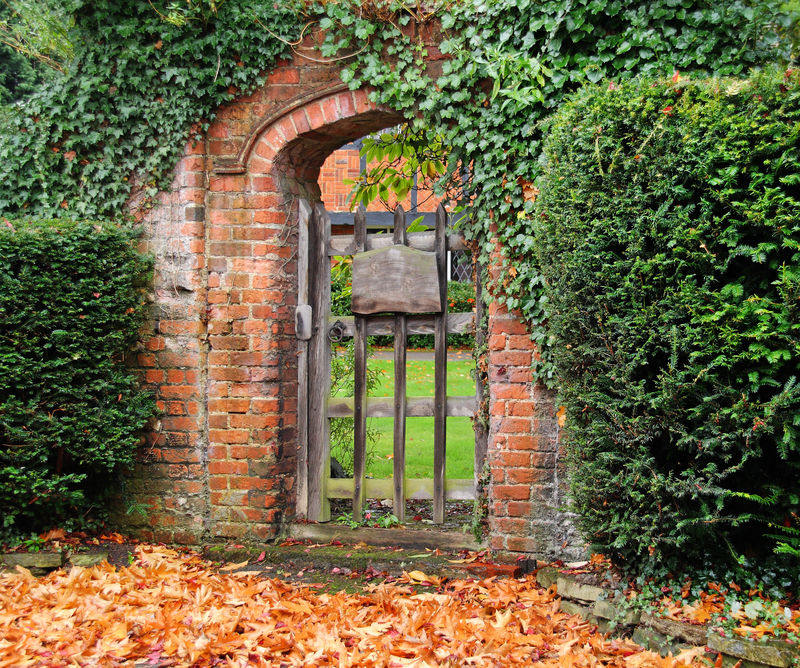Serenity in Your Backyard: Tips for a Zen Garden Space
Posted on 18/08/2025
Serenity in Your Backyard: Tips for a Zen Garden Space
Imagine stepping into your backyard and being greeted by a wave of calmness, tranquility, and peace. A well-designed Zen garden can turn this dream into reality. If you're looking to bring serenity to your backyard, creating an oasis inspired by ancient Japanese philosophy is a deeply rewarding project. In this guide, we'll share comprehensive tips for crafting your own Zen garden space, including principles, design elements, and maintenance strategies for lasting harmony.
What is a Zen Garden?
A Zen garden--also called a "Japanese rock garden" or "karesansui"--is a serene outdoor space designed to encourage contemplation and mindfulness. Traditionally, Zen gardens use all-natural elements: rocks, gravel, sand, moss, minimal greenery, water features, and sometimes wooden or stone sculptures. The essence of a Zen garden is simplicity, asymmetry, and balance--qualities that foster a sense of meditative tranquility right in your backyard.
Core Elements of Zen Gardens
- Gravel or Sand: Symbolizing water and the flow of energy.
- Rocks and Stones: Representing mountains, islands, or living beings.
- Minimal Plants: Moss, bamboo, and carefully pruned shrubs.
- Water Features: Ponds, streams, or stone basins for reflection and sound.
- Decorative Accents: Lanterns, bridges, and statues that reinforce tranquility.

Benefits of Creating a Zen Garden Space
Transforming your yard into a serene Zen garden brings more than just physical beauty; it offers mental and emotional well-being. Here are the major benefits:
- Reduces Stress: The simplicity and order of a Zen garden lower anxiety and promote relaxation.
- Enhances Mindfulness: Working in your garden and meditating within it encourages focus and presence.
- Increases Home Value: A well-designed outdoor sanctuary enhances curb appeal and property value.
- Supports Sustainable Living: Zen gardens use fewer resources and are generally low-maintenance.
Designing Your Backyard Zen Garden
1. Select the Ideal Location
Consider both sunlight and shade. Ideally, your Zen retreat should be in a quiet, undisturbed area with some natural shade. If possible, choose a location away from street noise or busy zones of your property, or use fencing and hedges to block distractions for maximum serenity.
2. Plan for Balance and Harmony
The heart of a serene Zen garden is balance--not symmetry. Use the principle of asymmetrical design to place rocks, plants, and water features in a way that feels harmonious without being evenly matched. Odd numbers are often used for groupings of rocks or shrubs, following Japanese tradition. Integrate open spaces to invite calm and create moments of reflection.
3. Embrace Minimalism
Less is more in a Japanese-inspired meditation garden. Avoid clutter. Every stone, shrub, and lantern should have a purpose. The serenity of your backyard Zen garden flourishes when you allow emptiness and simplicity to guide your design choices.
4. Define Boundaries
Use bamboo fencing, stone walls, or evergreen hedges to mark the edges of your contemplative space. Well-defined boundaries not only protect your serenity garden from distractions but also frame the landscape, drawing your focus inward.
Key Components of a Tranquil Zen Garden Space
Chose the Right Rocks and Stones
Rocks form the "bones" of a Zen garden. Select them thoughtfully. Vary sizes, shapes, and colors for natural appeal. Place large rocks as focal points, with smaller stones supporting them.
- Upright stones: Represent mountains or trees; position these to catch the eye.
- Flat stones: Symbolize water surfaces or stepping paths for meditation walks.
- Cluster stones: Use in uneven, odd-numbered groups, echoing the natural landscape.
Choosing Gravel and Sand
Spread white, gray, or beige gravel or sand across your garden bed. Rake patterns--like ripples or waves--to symbolize water flows or the wind's movement. The soothing task of raking regularly helps maintain mindful serenity in your backyard.
Incorporate Water Features
While not every Zen garden requires water, a simple pond, pebble stream, or stone basin ("tsukubai") can amplify calm. The gentle sound of moving water promotes relaxation and masks background noise. Choose natural shapes and keep decorations simple for an authentic feel.
Minimalist Plants for Tranquility
Plants in a Zen garden are understated. Focus on a few varieties:
- Moss: Offers lush green carpets and thrives in shady spots.
- Bamboo: Symbolizes resilience and grace; use as privacy screens or accents.
- Japanese maples: Deliver seasonal color and sculptural form.
- Evergreen shrubs: Add green structure year-round.
- Ornamental grasses: Provide movement and texture.
Prune all plants carefully for neatness and shape, reflecting intentional design and mindfulness.
Enhanced Ambiance with Decor
- Stone lanterns (toro): Light pathways or corners and add a sacred air.
- Bridges: Symbolic transitions--add a small arched bridge over gravel "streams."
- Buddha statues or pagodas: Can serve as focal points (keep subtle and respectful).
- Benches: Place in quiet nooks for seated meditation and observation.
Creating Serenity with Lighting and Sound
Natural Lighting
Take advantage of soft sunlight. Position your garden where it gets gentle light during mornings or evenings, highlighting the textural beauty of rocks and foliage. Dappled light through bamboo or maples adds an extra layer of serenity to your backyard retreat.
Soft, Subtle Outdoor Lighting
Install low-voltage LED lights, lantern-style fixtures, or path lights to enhance beauty and usability after dusk, without overwhelming the natural tranquility of your Zen space.
Peaceful Water Sounds and Wind Chimes
Add bamboo wind chimes or a slow-flowing water feature to invite soothing, meditative sounds. The gentle music of water and wind is an essential part of cultivating serenity in your garden.
Step-by-Step Guide to Building Your Zen Garden
- Mark the Area: Outline your garden footprint with string and stakes.
- Prepare the Soil: Remove weeds and grass, level the ground, and if needed, add landscape fabric to fight weeds.
- Set the Structure: Install stones, large rocks, and fencing or privacy screening.
- Add Sand/Gravel: Spread and even out your gravel/sand layer; use a rake to create patterns.
- Plant Selectively: Place moss, bamboo, shrubs, and other chosen greenery.
- Incorporate Features: Introduce water elements, lanterns, benches, and decorative touches for ambiance.
- Final Touches: Review and adjust for harmony, flow, and balance.
Maintenance Tips for a Lasting Sanctuary
Keep it Clean and Simple
Zen gardens are easy to maintain if you adhere to the minimalist philosophy. Here's how to keep serenity flourishing:
- Regular Raking: Restore raked patterns in gravel/sand frequently.
- Prune Carefully: Trim plants to maintain tidy lines and shapes.
- Remove Debris: Clear away fallen leaves, twigs, and litter.
- Check Water Features: Clean pumps, refill basins, and keep water fresh.
- Replace Gravel: Top up thin sections, and clean stained sand if needed.
These simple maintenance habits preserve both the aesthetics and the meditative energy of your retreat.
Incorporating Meditation and Mindfulness
The ultimate purpose of a Zen garden is to foster serenity, clarity, and mindfulness. Here's how to use your garden to its fullest spiritual potential:
- Meditate Outdoors: Sit quietly on a bench, cushion, or directly on the gravel in a cross-legged posture. Listen to the sounds, observe the patterns, and let your thoughts settle.
- Practice Walking Meditation: Walk slowly along a path or stepping stones, focusing on each footstep and your breathing. The deliberate pace cultivates deep awareness.
- Engage in Raking: The act of raking gravel into simple or elaborate designs is a meditative task that clears the mind and grounds your intentions.
Transforming Small Spaces: Zen Garden Ideas for Any Backyard
You don't need a large yard to enjoy the gifts of serenity. Even balconies, patios, and narrow side yards can become Zen-inspired sanctuaries! Try these tips:
- Container Gardens: Use wide, shallow planters to create mini gravel landscapes with stones and moss.
- Vertical Gardens: Incorporate bamboo screens, climbing vines, and hanging lanterns for an immersive feel without using floor space.
- Pocket Water Features: Compact bubbling fountains or stone basins add ambiance to patios and decks.

Frequently Asked Questions About Zen Garden Spaces
Do Zen gardens require a lot of upkeep?
Not at all! Zen gardens are low maintenance by design. Regular raking, occasional pruning, and debris removal are the main tasks. This simplicity is what makes them a perfect solution for busy homeowners seeking tranquility.
How can I make my backyard more serene without a full Zen garden?
Even just adding elements such as a raked gravel patch, a few stones, or a small bamboo water fountain can infuse everyday serenity into your outdoor space. Gradually incorporate more features as your time and budget allow.
What are the best plants for a Zen garden?
Mosses, bamboo, dwarf conifers, maples, ornamental grasses, and compact azaleas are excellent choices. Select plants with soft color palettes and minimal, sculptural forms for harmony and peace.
Can I use a Zen garden as a family space?
Absolutely. While Zen gardens are designed for contemplation, they are also beautiful spaces for quiet conversation, reading, or gentle play. Set clear guidelines so that the garden retains its tranquil character.
Conclusion: Cultivate Lasting Serenity in Your Backyard
Creating a Zen garden sanctuary in your backyard is about more than landscaping--it's a way to invite balance, quiet, and mindful living into your daily routine. With careful design, thoughtful element selection, and regular care, your garden will become a true haven of serenity, ready to restore your spirit at any time. Whether you have a sprawling lawn or a compact patio, the path to transformative tranquility is within your reach.
Start planning your backyard Zen garden today and let serenity blossom outside your door.

